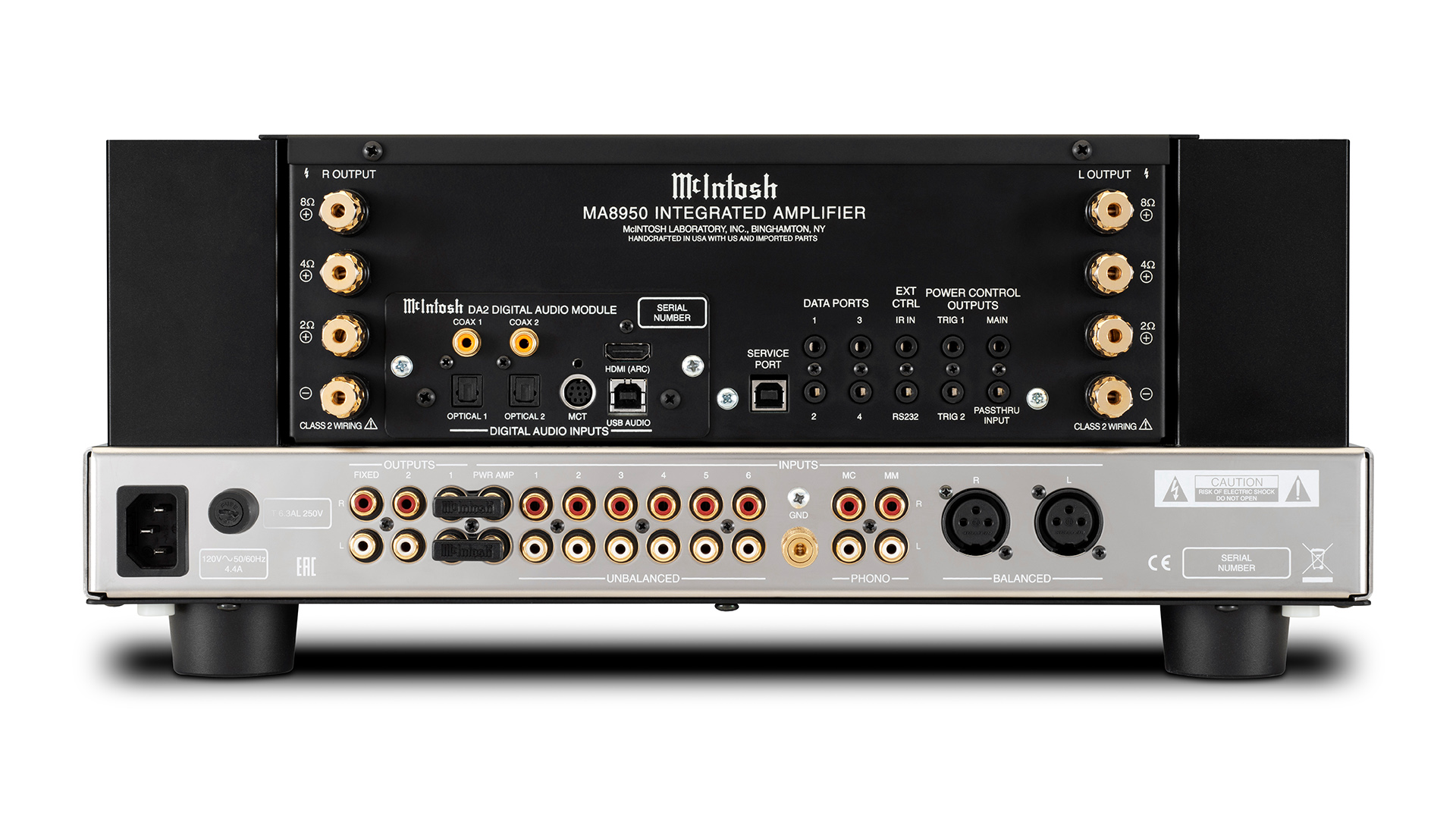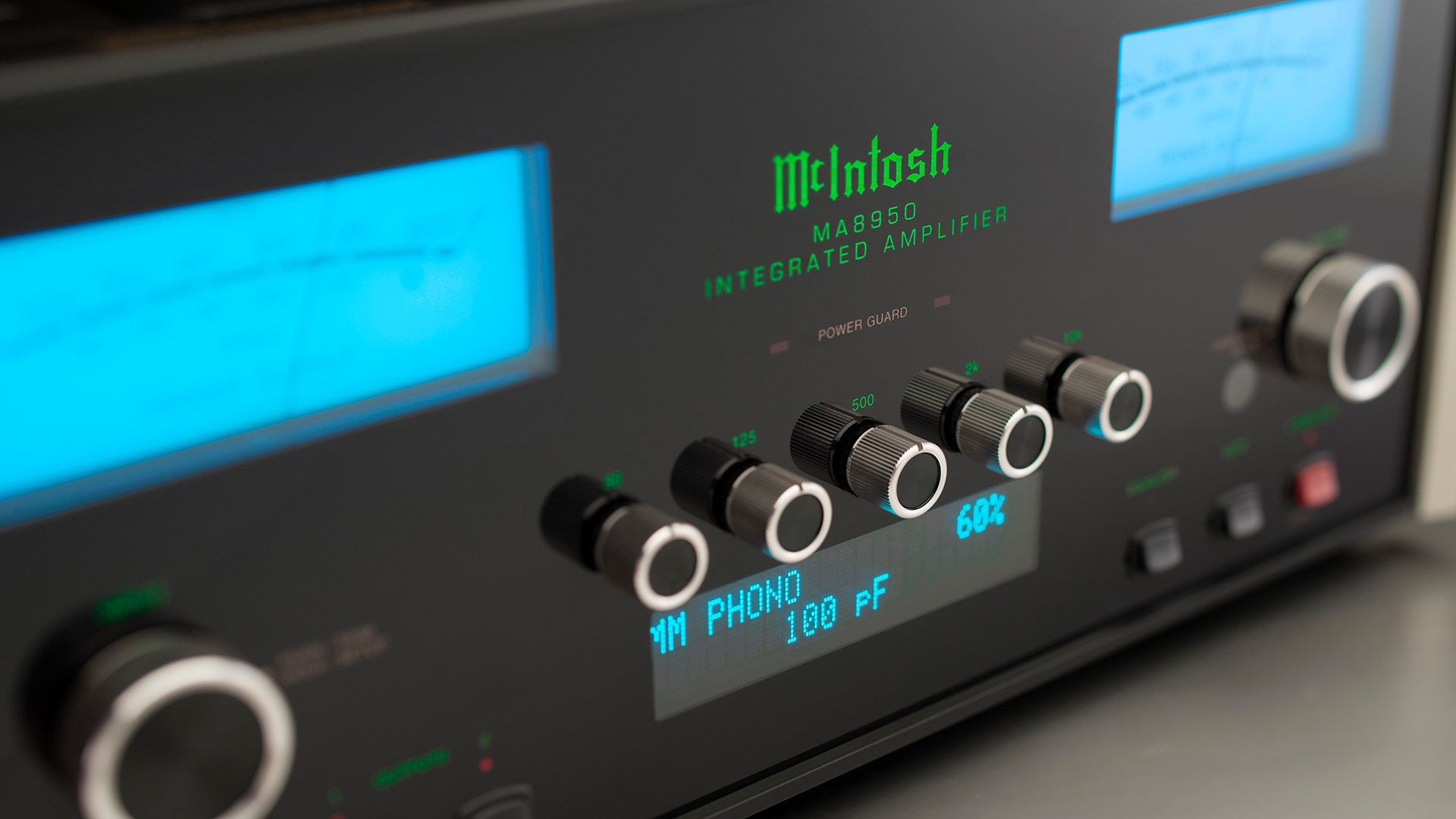What Hi-Fi? Verdict
The McIntosh MA8950 combines a generous spec sheet with an articulate and composed sound. There is much to admire here
Pros
- +
Fluid and articulate performance
- +
Composed, easy-going presentation
- +
Well-equipped and flexible
Cons
- -
Sound lacks some rhythmic drive
- -
Creaky remote
- -
Front panel controls feel cheap
Why you can trust What Hi-Fi?
We are of the opinion that high-end integrated amplifiers should pack in every feature that prospective customers are likely to need. After all, what’s the point of spending thousands on a single-box solution only to find that you still need to add an outboard phono stage or DAC to make your system work? Take a look through the MA8950’s extensive feature list and it seems McIntosh agrees.
Build & features

There is no denying that the MA8950 is something of a beast. While this amplifier sits broadly in the middle of the company’s integrated range, there is nothing remotely modest about it, from the vertebrae-straining 34kg weight to the generous 200 watts-per-channel claimed power output. And that’s the output regardless of whether you connect to the 2-, 4- or 8-ohm speaker connections on the back panel, too.
We are used to seeing such a choice of connections on the back of valve amplifiers, but not on those of a transistor persuasion. This is something that sets McIntosh’s designs apart from their transistor-based rivals and involves using an autoformer between the output transistors and the speakers. Doing things this way is claimed to reduce the stress on the electronics and so make the amplifier more load tolerant.
Which of the three speaker output options should you use? We would start with the ones that are closest to the nominal impedance of your speakers, but there is no harm in trying the others. In our experience, it isn’t hard to identify the optimum option.

Type Integrated
Power output 200 watts per channel
Analogue inputs 6x single ended RCA, 1x balanced XLR
Digital inputs USB Type B, coax x2, optical x2, HDMI (ARC), MCT
Preamp output Yes
Dimensions (hwd) 19 x 45 x 48cm
Weight 34kg
The MA8950 is about as well equipped a high-end integrated amplifier as we have seen. We doubt whether this unit will ever be found wanting in any reasonable two-channel context. It has seven line-level inputs, one of which is balanced. And there are dedicated phono inputs for both moving magnet and moving coil cartridges, with the latter offering a degree of adjustability to optimise performance. If the inclusion of a record player input makes you think that this is a somewhat traditional, backward-looking design for those who view the '70s through some rose-tinted spectacles, don’t worry – the MA8950 is much more of an all-rounder than that. It also includes McIntosh’s highly specified DA2 digital module that supports high-res music files up to 24-bit/192kHz PCM and DSD512.
There is a generous spread of digital inputs with two coaxials, two opticals, a USB Type B, an HDMI (ARC), and an MCT input for connection to a McIntosh SACD/CD transport. We are particularly pleased to see the inclusion of an HDMI, as it makes integrating the MA8950 into an AV system more fuss-free.
As for outputs, this integrated has two selectable preamp options, which are accessed through a pair of buttons by the 6.3mm headphone socket on the front panel. Output 1 connects to the internal power amp input through a pair of short external links, while the second output can be used to drive an outboard power amplifier or, possibly more likely, feed a subwoofer.
The latest hi-fi, home cinema and tech news, reviews, buying advice and deals, direct to your inbox.
Look at the McIntosh’s front panel and you will find a usefully large digital display that shows the volume level and input chosen, and proves handy in the initial set-up process. Above it you will find a line of five rotary controls that govern the amplifier's tonality, each looking after a specific band of frequencies. These tone controls can be taken out of the circuit for those who have more purist leanings.
The amplifier’s general build quality is broadly on par with what we would expect at the price. The MA8950 is an impressively solid unit that is very nicely finished on the whole. We love the glass front panel and, of course, those trademark blue, back-lit power meters are hugely appealing.
It’s not beyond criticism, though. We wish all the rotary controls – tone, input and volume – turned with a slicker, more polished feel. There is a slight coarseness to their movement that we don’t like. We also want them to feel more substantial given the price. But, let us make things clear: everything works and nothing feels as though it will fall off, even with a decade's worth of use. The relatively smart-looking but slightly cluttered system remote doesn’t help the impression of quality either, as it creaks slightly when twisted or squeezed. The company should do better here.
Any amplifier at this level positively demands talented sources and speakers. We oblige with the Naim ND555/555 PS DR and Linn Klimax DSM AV music streamer. The MA8950’s phono inputs are tested with a Technics SL-1000R turntable fitted with either a Vertere Sabre moving magnet cartridge or, to feed the moving coil input, Kiseki’s Purpleheart MC. We use our usual reference ATC SCM50 speakers for the bulk of testing but also give ProAc’s Response D2R a listen.
Sound

Once we give the McIntosh a few days to settle it delivers almost exactly what we hoped it would. It has a large scale, effortless sound that is inviting and ever so easy on the ears. There is a pleasing loose-limbed quality to its presentation that sounds almost valve amp-like in its fluidity, yet there’s also the kind of grip at low frequencies that few valve designs actually get close to.
We play Tchaikovsky’s 1812 Overture and the McIntosh sounds right at home. The MA8950 has the insight and organisation to make sense of the mass of instrumentation and couples that with wide-ranging dynamics and sledgehammer punch when the music demands. It’s an admirably large-scale sound; one packed with authority yet with enough finesse to avoid sounding musclebound.
Through the line-level inputs, detail levels are good rather than outstanding for the money, but there is a pleasing sense of musical coherence that draws us into the performance. We like that the amplifier remains calm and in control even when pushed hard. Refinement is generally excellent and at any normal listening levels there is no sign of unwanted edge or hardness to the sound.
The amplifier’s stereo imaging is nice and wide with a good impression of depth. It’s not as precisely etched as some we have heard but stays stable even when the music becomes demanding.
We take some time to play around with the MA8950’s five-strong tone controls and can see their value in situations where a recording is particularly poor or perhaps the listening room is compromised. When not needed, they are easily taken out of the circuit with the press of a button.
Do that and you will find that the MA8950’s natural tonality is on the slightly full and smooth side of neutral without going too far. It’s a balance that is relatively forgiving of aggressive recordings and easy to partner with when it comes to system building.
Switching to Catch A Fire by Bob Marley and the Wailers shows that the McIntosh is able to change gear when required. It sounds bright and breezy on the evergreen Stir It Up and then shifts effortlessly to showing appropriate grit on Concrete Jungle. Marley’s passionate vocals highlight the McIntosh’s open and airy midrange and its high levels of clarity. Basslines are taut enough, nicely textured and are delivered with a convincing sense of power. The MA8950 doesn’t quite have the rhythmic precision to truly get our feet tapping but it remains an engaging listen nonetheless.
While the sound through digital inputs lacks a little of the transparency and dynamic expression of the line stages, listening through them is still an enjoyable experience. Detail levels are good and the general character retains the listenability we so like from the analogue inputs. We try a range of recordings from 24-bit/192kHz OST of The Dark Knight Rises to Stevie Wonder’s Innervisions on DSD and the McIntosh shifts slickly between the formats without issue. In absolute terms, the digital module is broadly on a par with the likes of the Chord Mojo 2 when it comes to performance.
Integrating a sensitive circuit such as a phono stage into such a complex single-chassis amplifier isn’t easy, but McIntosh has managed well here. Both the moving magnet and moving coil circuits are relatively quiet and retain the pleasing character of the MA8950’s other inputs.
We are pleased that the company has implemented a way of adjusting the cartridge loading on the MC input, as it’s important to optimise the electrical parameters with such cartridges. Even so, despite the obvious clarity of the moving-coil input, we prefer the bolder, more dynamically punchy presentation we hear through the moving-magnet option.
Ultimately, if vinyl replay were a priority, we would go for a dedicated phono stage of at least the standard of Vertere’s Phono-1 MkII over using the one fitted here. For casual listening, however, it is perfectly acceptable.
There are no such misgivings about the headphone output. This is clear and insightful sounding and works particularly well with our Grado RS 1 headphones. We like that the McIntosh’s forgiving character ensures the occasionally uncouth RS1 stay well behaved, which allows their otherwise exceptionally musical nature to shine through. The selectable HXD (Headphone Crossfeed Director) processing mode, which attempts to emulate the soundstage perspective of speakers through the headphones, works pretty well, though it sacrifices a little crispness and precision on the way.
Verdict

The MA8950 is a hugely impressive amplifier. McIntosh’s high-end experience shines through both in the thorough execution of the product and the way in which such a wide range of features have been so seamlessly integrated. We have slight misgivings about some aspects such as the remote handset and front panel control feel, but they are not enough to overshadow what is a very fine effort. Looking for a high-power integrated amplifier to cover any and all two-channel requirements? This one deserves to be high on the list.
SCORES
- Sound 4
- Build 4
- Features 5
MORE:
Read our review of the Luxman L509X
Also consider the Krell K-300i
Read our Technics SU-R1000
Best stereo amplifiers 2022: the best integrated amps you can buy
What Hi-Fi?, founded in 1976, is the world's leading independent guide to buying and owning hi-fi and home entertainment products. Our comprehensive tests help you buy the very best for your money, with our advice sections giving you step-by-step information on how to get even more from your music and movies. Everything is tested by our dedicated team of in-house reviewers in our custom-built test rooms in London, Reading and Bath. Our coveted five-star rating and Awards are recognised all over the world as the ultimate seal of approval, so you can buy with absolute confidence.

